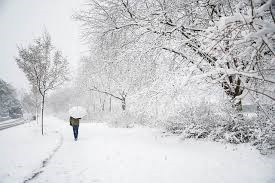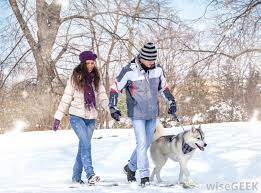It turns out that snow days can be good for more other than seeing it just on Christmas eve night, Christmas day, New Years Eve night and New Years Day or for building a snowman and hot cocoa on a day off especially with the kids. Mother Nature may be doing your mind and body a good healthy favor with all those extra flakes.
Here are the Pro’s of Snow to the human being:
The power of sleep is well documented. Getting the right amount of shuteye (seven to eight hours for most people) can make us better athletes, help maintain a healthy weight, ward off Alzheimer’s disease, and result in fewer sick days from work. Sleep has also been linked to forming new memories, and may lead to improved brain function and memory later in life. So sleeping in an extra hour or so on a snow day may mean a better functioning, healthier you.
Playing outside is considered exercise; take trekking through the snow can be a serious workout. An hour of snowshoeing burns 500 calories and an hour of cross country skiing, more than 570. Dodging snowballs in a snowball fight can also zap around 500 calories per hour from light jogging. Hiking up hills to sled down can also burn more than 500 in one hour. Even building a snowman is a way to get your heart pumping and crush nearly 300 calories per hour, Pop Sugar reports.
Spending the day curled up in bed or on the couch with a good book may also improve your health and happiness, believe it or not. Don’t feel like battling the cold temperatures? Diving into a good book comes with its own benefits. Research has linked the habit to staving off Alzheimer’s disease and reducing stress. Plus, reading can improve brain function. So stock up on cozy blankets and enjoy the health perks, bookworms.
Snow days force us to take a vacation. Many of us work a lot. More than 40 percent of Americans who receive paid vacation don’t actually use all of their days off. Not taking time off can actually hurt our productivity at work. But snow days push us to take some time to ourselves.
According to David Hansen, a University of Delaware Cooperative Extension soil and environmental quality scientist.
The phrase “blanket of snow” is more than a visual description — it’s also accurate in terms of warmth, says Hansen.
Freshly fallen, un-compacted snow is typically 90 to 95 percent trapped air. Because the air can barely move, heat transfer is greatly reduced, thus slowing the flow of heat from the warm ground to the cold air above. Farmers need snow, plain and simple. They need snow to blanket their fields so that when it all melts in the spring, their fields are properly irrigated and ready for planting. Snow is also necessary for farmers that plant certain crops in the fall. Winter wheat that is planted in the prairies need to be blanketed in snow in order to provide insulation from extreme cold. When these crops are exposed to the elements, they become vulnerable to frost which can kill the crop outright. Other crops that are planted in the fall require snow to protect the seeds from predators like birds. This blanket effect makes snow an excellent insulator for farmers land but also gardens and landscapes. This blanker is great in protecting these natural areas and their animal inhabitants against frigid temperatures and damaging winds. This blanket is good to our health.
Generally, temperatures underneath a layer of snow increase about 2 degrees Fahrenheit for each inch of accumulation. Because the soil also gives off some heat, the temperature at the soil surface can be much warmer than the air temperature. Hansen says that a study done at minus 14 degrees Fahrenheit found that the soil below a 9-inch deep snow registered a surface temperature of 28 degrees.
Snow also lessens — to some extent — the extremes of temperature fluctuation to which the soil is subjected, says Hansen. This can be critical for some plants, including evergreens. Even in mid-winter, if air temperature within the canopy of these plants rises during the day, the plants will try to take moisture from the soil. If the soil is frozen, the plants can actually die of thirst.
Snow is great for our economy and you ask how? Well look at this, When a lack of snow contributes to agricultural shortages, the end result is often that the prices for food will rise. Under the laws of supply and demand, a reduced supply will cause increased demand which then drives the price up. When we start seeing higher prices for basic food staples due to a lack of snow fall months earlier, it affects us in ways we don’t initially expect.
When we lack snow that can be a headache for snow resorts. In history there has been shut downs of ski resorts resorting to lack of business for owners and lack of fun for lovers in skiing. Back in the year 2006-2007 the biggest resort in Ontario call Blue Mountain had to be forced to shut down in Dec and Jan due to lack of snow with trails not with enough and dangerous. In 2013 statistics showed a 15% drop in visitors regular and new to ski resorts. So it would help to have snow for ski resorts especially in NE as opposed in the Northern area in the West; so for employers and employees of ski resorts it definitely can effect their economy with impacting others who look forward to skiing.
Snow is a natural part of the ecological cycle in this part of the world and when we start seeing the cycle becoming all messed up, the consequences begin to pile up which can be far more problematic than the pile up of snow at the end of our driveway that by and large we have not had to deal with much over the past few years compared to years prior. So when take a holistic approach of look at snow especially at the end of our driveway that it isn’t so bad after all.

